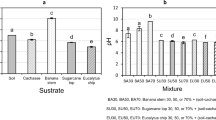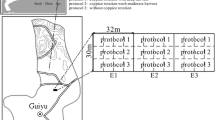Abstract
Microbial ethylene (C2H4) consumption was studied as a method of reducing the ethylene concentration during ethylene exposure of Begonia elatior in transport simulation boxes. Potted plants were exposed to an air flow (ca. 164 L h-1) with 0–1.03 ppm ethylene for 4 days in the presence of horticultural peat-soil that was induced to microbial ethylene consumption or in the presence of ethylene-oxidizing bacteria added to the peat-soil in the Begonia pots (referred to as plant soil). Ethylene consumption during transport simulation was enhanced by both procedures. However, the maximal extent of the reduction in ethylene concentrations (11–50%) was too low to significantly improve the keeping quality of the Begonia, which are known to be sensitive to ethylene exposure. A distinct ethylene consumption was due to the presence of potted Begonia in the transport simulation boxes. Batch experiments with plant soil verified such a capacity of microbial ethylene consumption. In addition, plant soil with added ethylene-oxidizing bacteria proved to be highly efficient for ethylene removal even to levels below our 0.002 ppm detection limit. With an optimized scrubber system such ethylene removal could be of further interest as a novel method of ethylene removal during transport and storage of horticultural produce.
Similar content being viewed by others
References
Abeles F B 1982 Ethylene as an air pollutant. Agric. Forest. Bull. 5, 4–12.
Abeles F B, Craker L E, Forrence L E and Leather G R 1971 Fate of air pollutants: removal of ethylene, sulfur dioxide, and nitrogen dioxide by soil. Science 173, 914–916.
Abeles F B, Morgan P W and Saltweit Jr M E 1992 Ethylene in Plant Biology, 2nd edn. Academic Press Inc., San Diego. 414 p.
Arshad M and Frankenberger W T Jr 1988 Influence of ethylene produced by soil microorganisms on etiolated pea seedlings. Appl. Environ. Microbiol. 54, 2728–2732.
Arshad M and Frankenberger W T Jr 1990 Ethylene accumulation in soil in response to organic amendments. Soil Sci. Soc. Am. J. 54, 1026–1031.
Arshad M and Frankenberger W T Jr 1991 Microbial production of plant hormones. Plant and Soil 133, 1–8.
Arshad M and Frankenberger W T Jr 1998 Plant growth-regulating substances in the rhizosphere: microbial production and functions. Adv. Agron. 62, 45–151.
de Bont J A M 1976 Oxidation of ethylene by soil bacteria. Antonie van Leeuwenhoek 42, 59–71.
De Heyder B, Overmeire A, van Langenhove H and Verstraete 1994 Ethene removal from synthetic waste gas using a dry biobed. Biotechnol. Bioeng. 44, 642–648.
Elsgaard L 1996 Ethylene degradation in peat-soil for horticultural practice. Abstracts of the NATO Advanced Research Workshop on Biology and Biotechnology of the Plant Hormone Ethylene, 9–13 June 1996, Chania, Greece. p 97.
Hartmans S, de Bont J A M and Harder W 1989 Microbial metabolism of short-chain unsaturated hydrocarbons. FEMS Microbiol. Rev. 63, 235–264.
Høyer L 1985 Bud and flower drop in Begonia elatior ‘sirene’ caused by ethylene and darkness. Acta Hortic. 167, 387–391.
Høyer L 1995 Investigations of the ethylene build-up during transport of pot plants in controlled temperature trucks. Postharvest Biol. Technol. 5, 101–108.
Hyodo H 1991 Stress/wound ethylene. In The Plant Hormone Ethylene. Eds. A K Mattoo and J C Suttle. pp 43–64. CRC Press, Inc., Florida.
Kadar A A 1985 Ethylene-induced senescence and physiological disorders in harvested horticultural crops. HortScience 20, 54–57.
Knee M, Proctor F J and Dover C J 1985 The technology of ethylene control: use and removal in post-harvest handling of horticultural commodities. Ann. Appl. Biol. 107, 581–595.
Otani T and Ae N 1993 Ethylene and carbon dioxide concentrations of soils as influenced by rhizosphere of crops under field and pot conditions. Plant Soil 150, 255–262.
Rudolphij Jr J W and Boerrigter H A M 1981. Scrubbers voor ethyleen. Bedrijfsontwikkeling 12, 307–312.
SAS Institute 1989 SAS/STAT Users guide (version 6), 4th edn. SAS Institute, Inc., Cary, North Carolina.
Sawada S 1985a Fundamental studies on dynamics of ethylene in an ecosystem. I. Atmospheric ethylene concentrations in a Fagus cretena forest and above paddy fields during burning of agricultural wastes. Jap. J. Ecol. 35, 215–223.
Sawada S 1985b Fundamental studies on dynamics of ethylene in an ecosystem. II. Atmospheric ethylene levels in a tropical rain forest of the Colombian Amazon region. Jap. J. Ecol. 35, 291–295.
Sawada S and Totsuka T 1986 Natural and anthropogenic sources and fate of atmospheric ethylene. Atmos. Environ. 20, 821–832.
Sawada S, Nakahata K and Totsuka T 1985 Fundamental studies on dynamics of ethylene in an ecosystem. III. Degradation capacity of atmospheric ethylene in soils taken from various vegetations. Jap. J. Ecol. 35, 453–459.
Sherman M 1985 Control of ethylene in the postharvest environment. HortScience 20, 57–60.
Smith K A, Bremner J M and Tabatabai M A 1973 Sorption of gaseous atmospheric pollutants by soils. Soil Sci. 116, 313–319.
Turner M A, Reed D W and Morgan D L 1988 Ethylene-induced defoliation in Ficus species and ethylene depletion by soil bacteria in peat-amended media and in vitro. J. Amer. Soc. Hort. Sci. 113, 794–796.
van Ginkel C G and de Bont J A M 1986 Isolation and characterization of alkene-utilizing Xanthobacter spp. Arch. Microbiol. 145, 403–407.
van Ginkel C G, Welten H G J and de Bont J A M 1987 Growth and stability of ethene utilizing bacteria on compost at very low substrate concentrations. FEMS Microbiol. Ecol. 45, 65–69.
Widdel F and Bak F 1992 Gram-negative mesophilic sulfate-reducing bacteria. In The Prokaryotes, 2nd edn. Eds. A Balows, H G Trüper, M Dworkin, W Harder and K H Schieifer. pp 3352–3378. Springer-Verlag, New York.
Zar J H 1996 Biostatistical Analysis, 3rd edn. Prentice-Hall Inc., Upper Saddle River, N.J. 662 p.
Author information
Authors and Affiliations
Rights and permissions
About this article
Cite this article
Elsgaard, L., Andersen, L. Microbial ethylene consumption in peat-soil during ethylene exposure of Begonia elatior. Plant and Soil 202, 231–239 (1998). https://doi.org/10.1023/A:1004357506418
Issue Date:
DOI: https://doi.org/10.1023/A:1004357506418




